- Water, air and light are essential for the development of living organisms, and cannabis is no exception.
- In this post, we will look at air management for indoor growing environments, a key aspect for a successful crop both in terms of quantity and quality.
- Good air circulation will save you a lot of trouble in your growing space. Keep scrolling to find out more and make sure your plants grow in the best possible conditions.
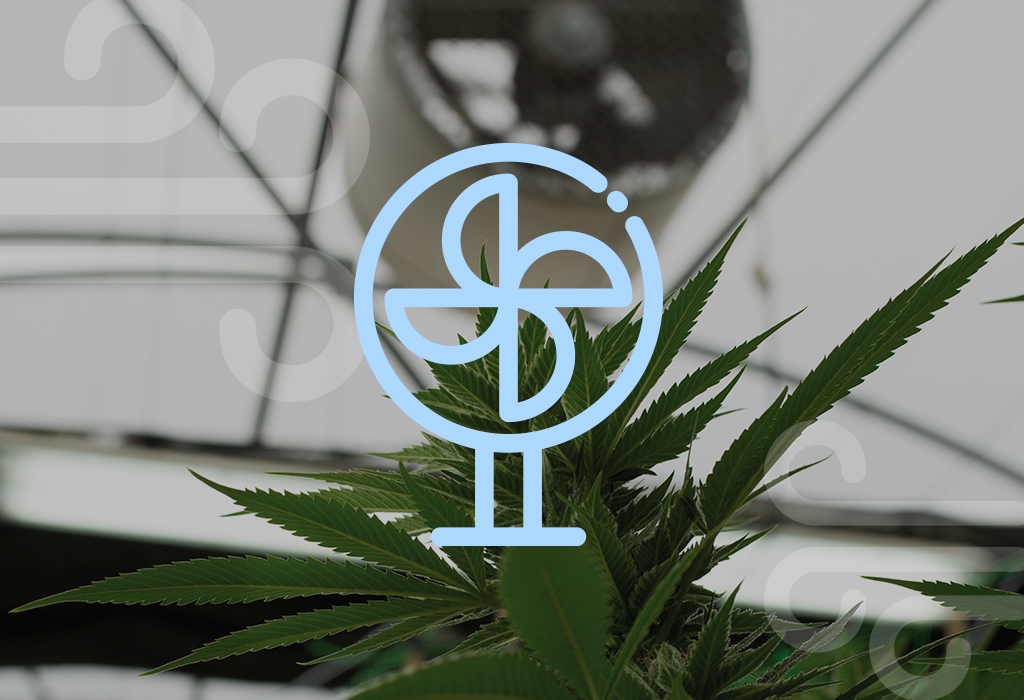
The cannabis plant, a living organism that respires
First of all, let's have a look at the respiration of plants so that you can better understand the role of air in cannabis growing. Plants respire just like any other living organism, and even if their needs are more basic than humans', they do need a well-ventilated growing space in order to develop to their fullest potential.
Plants respire through their leaves, stems and roots in what is called 'aerobic respiration', which uses oxygen as an oxisider. There are two types of plant respiration: photorespiration, which is light-dependent, and dark respiration, which is not. Respiration, thus, occurs round the clock, but it is more intense at night because photosynthesis ceases.
When photosynthesis is active, plants carry out a number processes at a time, this is why their respiration capacity is greater in the dark. So if you want your plants to respire comfortably, it is important to make sure night temperature is lower than day temperature. Also, keep the roots and substrate well oxygenated, as these are major exchange surfaces with a direct impact on plant development. If you are using organic soil, you will need greater oxygenation, as the microorganisms present in the soil are living beings that have oxygen needs too. Another thing to consider is substrate porosity, which directly affects the soil's respiration capacity. This can be improved by adding coco coir, perlite or white peat to the soil mix.
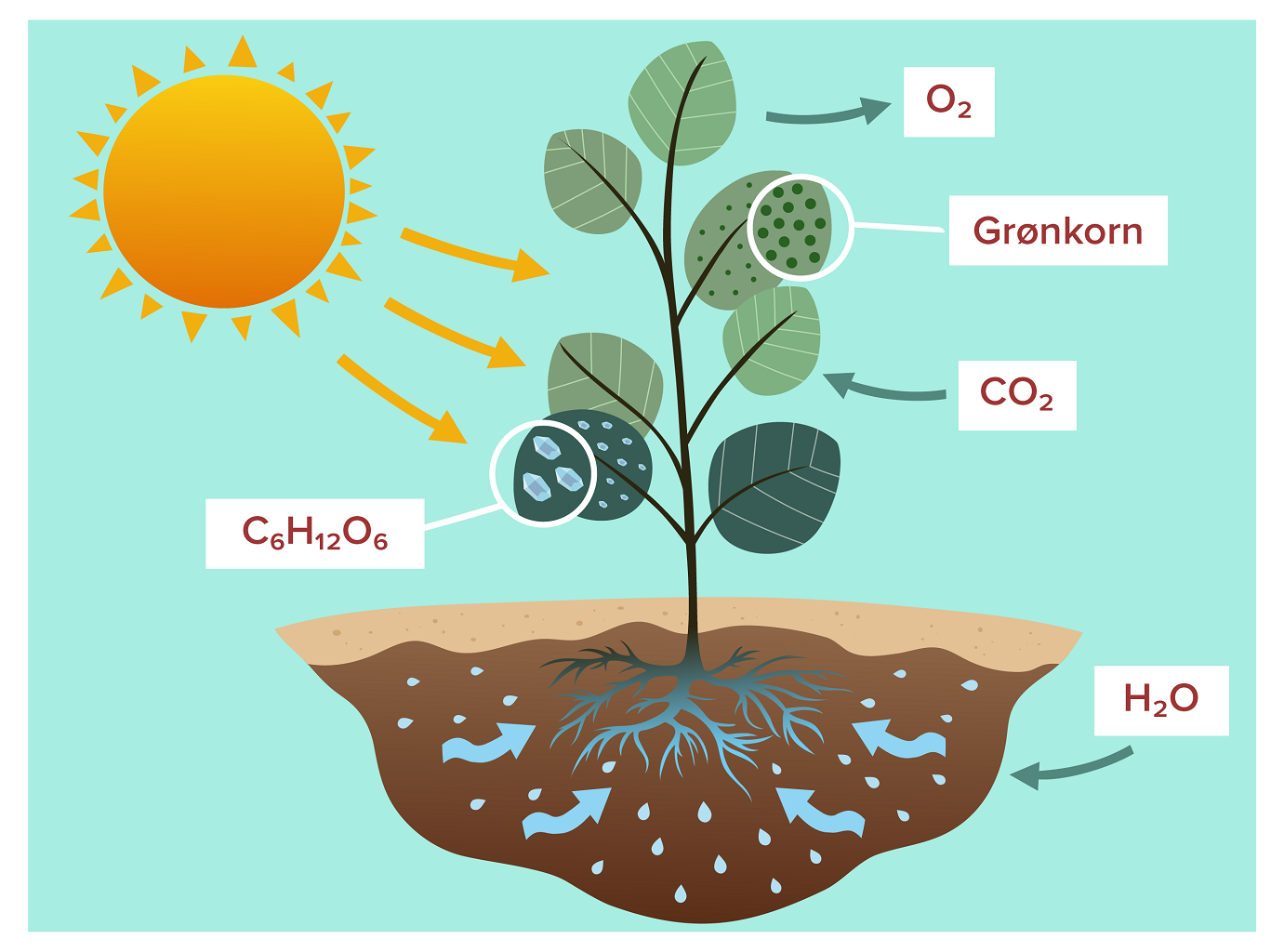
Another key aspect of plant respiration are stomas. These are microscopic pores that act as nostrils and that plants use to absorb carbon dioxide (CO2) and release oxygen (O2). Even if most stomas are located on the underside of leaves, it is important to spray warm water (20-25 ºC) on both surfaces at least once or twice a month to keep them clean from dust. Given their microscopic size, stomas get clogged easily, so make sure you clean the leaves regularly in order to ensure optimal foliar respiration capacity. This is not necessary outdoors, where the rain does all the work for you.
During the day, when photosynthesis occurs, the plant absorbs carbon dioxide and releases oxygen. At night, the process is reversed and the plant absorbs oxygen and releases carbon dioxide. This is why green, chlorophyll-rich plants are not allowed in hospital rooms at night.
Outdoors, air circulation is naturally generated and regulated through the wind. Indoors, however, you will need the aid of some strategically located fans to make sure the air is distributed evenly throughout the growing space. As for air exchange, you will need an intake fan to bring fresh air in and an exhaust fan to eliminate stale air. That said, normally one fan is enough, as you can use it both for intake and exhaust purposes just by turning it around.
The role of air circulation in cannabis growing
Air circulation in the growing space is key to a successful grow. Whether you are using a grow tent or a grow room, the most important aspect is to ensure constant air exchange based on the size of the growing space. Air management in indoor growing is structured around three axes: cleaning of the stomas, air circulation and air exchange, as these are key to ensure healthy plant grow.
The air must be distributed evenly throughout the entire space, where it needs to be regularly exchanged in order to avoid stagnant air areas and 'air pockets'. Constant air circulation is essential to obtain a well-balanced environment where the air is neither too dry or too moist, as this will help you meet the requirements of temperature, humidity and oxygen intake, which will in turn contribute to creating the right environment for proper plant development.

Where possible, it is important to avoid or at least minimise air layers, as cold air tends to flow downwards and hot air accumulates at high points, resulting in slower plant development and in mould and insect growth.
Other problems you may encounter include weakening of the plant structure, increased stress, excess transpiration and decreased flower density, which may in turn result in an unsatisfactory crop both in terms of quantity and quality (flavour and aroma). This is why recreating the outdoor climate conditions as accurately as possible is so important.
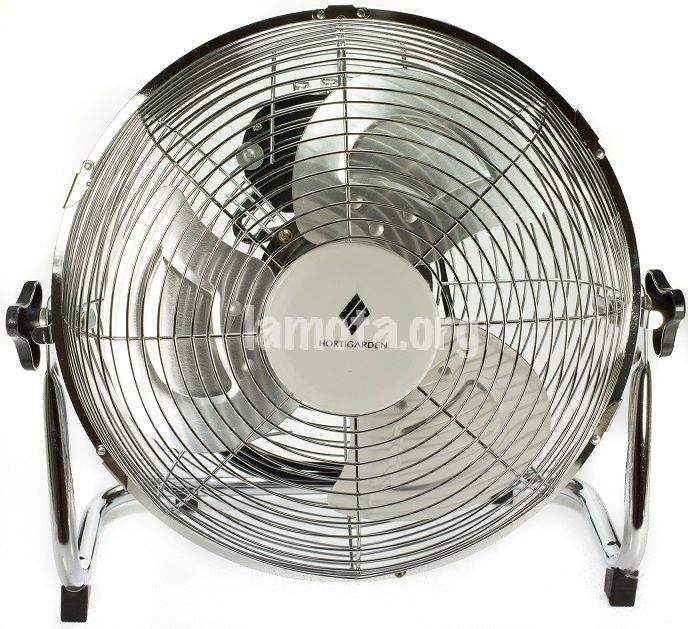
Necessary equipment for proper air circulation and exchange
1) Exhaust fan: A key element in air management, it extracts oxygen-deficient air from the growing space. Exhaust fans create the necessary climate conditions for proper plant development, directly affecting the success of the different stages of the crop. This is why we recommend going for quality over price, as it is a lot more convenient in the long run. As a rule, it is also preferable to choose larger fans in order to prolong the useful life of the equipment- wear and tear is reduced when not at full capacity.
2) Intake fan: Identical to exhaust fans except for the positioning (reversed) and the power (generally lower), they contribute to air circulation by bringing fresh, oxygen-rich air into the growing space. As with exhaust fans, high quality models are preferred on account of their longer useful life.
3) Acoustic box: An optional device that dampens the noise of the exhaust/intake fan for greater discretion.
4) Active carbon filter: A must-have if you are growing highly aromatic strains and your neighbours are not as enthusiastic about marijuana as you are. The filter effectively absorbs smells through the active carbon helping you keep a lower profile.
5) Ventilation ducts (exhaust/intake): Available at different prices and in all sorts of materials, ranging from aluminium and PVC to more sophisticated lining that ensures optimum sound insulation, the choice should be a compromise between your needs and your budget.
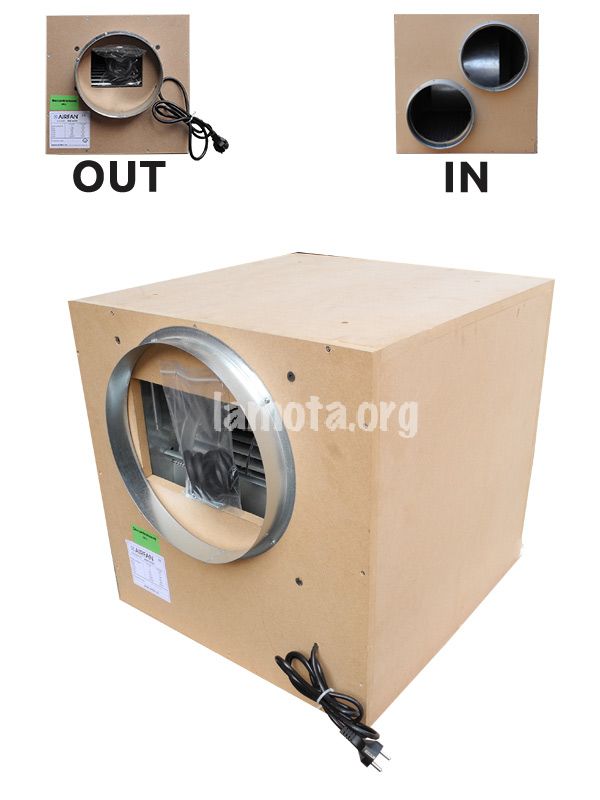
6) Floor fan: Used mainly in large grow rooms to recirculate the air near the floor. Generally, they operate at different speeds, adapting to different room sizes. Large diameter models are preferred over smaller models as they cover larger surface areas.
7) Oscillating stand fan: Used to cool the foliage and the vegetative structure as well as to ensure uniform air distribution in the grow room, this is another must-have piece of equipment. Fitted with multi-speed function for adaptability to all types of growing spaces.
8) Ceiling suspended fan: Generally, these are small/medium-sized floor fans that are suspended from the ceiling - between the lamp and the top of the plant - to cool the layer of hot air that builds up in that area, which is highly damaging to the plant as it causes stress, excess transpiration and even burns on the tips of upper leaves.
9) Clip fan: This is a small diameter fan that is mainly used in grow tents. Fitted with a clip, it is fixed directly to the grow tent structure, ideally with a size of one square meter.
10) Thermohygrometer: Measures the temperature (in F and C) and the humidity (%) in the grow room (wide measuring ranges), the two most important variables when it comes to monitoring the climate conditions of your growing space. Ideally, thermohygrometers should be placed at different points to make sure air temperature and humidity are the same all over the room.
11) Humidifier: Depending on the environmental conditions of the area, you may use a humidifier to increase the humidity in your grow room.
12) Dehumidifier: This is something you really need to use if your grow room is too humid. High air humidity is synonymous with fungi, pests and all sorts of similar problems, so choose a high-performance model and go for quality over price.
If you want to calculate the electricity cost of your growing equipment, you can check out this post.
Setting up a grow tent
This grow tent will give you a clearer idea of the climate needs of a growing space.
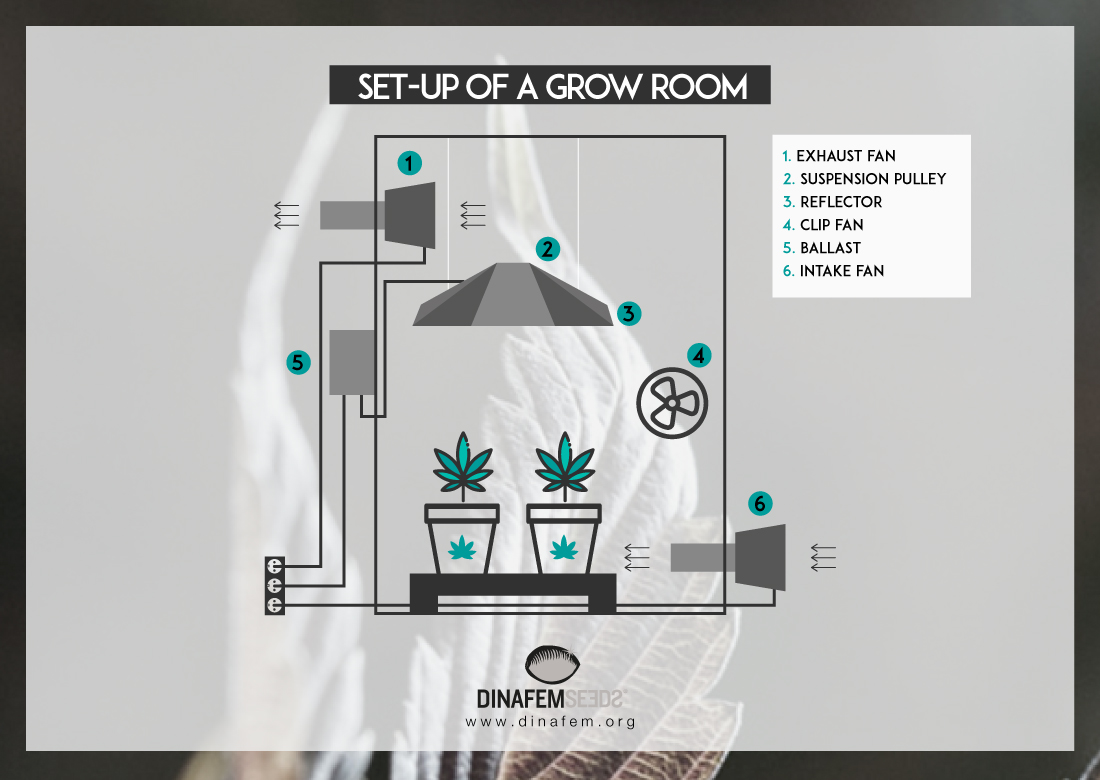
The only important thing to consider here is that you won't need an intake fan, as air intake will occur naturally. Thus, an exhaust fan is all you'll need to ensure proper air exchange. Also, consider that the grow tent will generate some 'light pollution' as light will filter through the intake fan hole, which needs to be open in order to ensure passive air intake.
Setting up a grow room
Grow rooms are more complex to set up as you will need more pieces of equipment to ensure proper air exchange and circulation. Because of the larger dimensions, the air is not distributed as evenly as in grow tents - it accumulates and gets stale faster - and is more subject to temperature and humidity changes, ultimately causing significant climate instability.
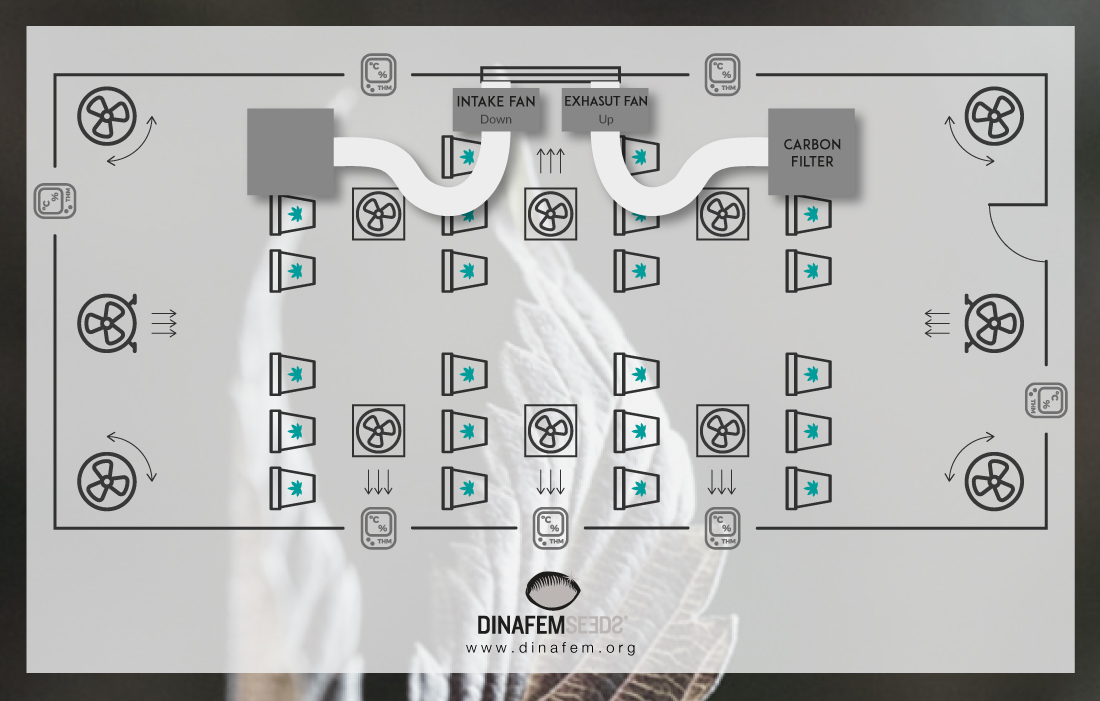
But there's no need to panic, here is a diagram to help you optimise the arrangement of your equipment. If your grow room has similar dimensions and you stick to this layout, there's nothing to worry about - at least as far as air circulation is concerned.
How to choose the exhaust/intake fan that best suits your grow room
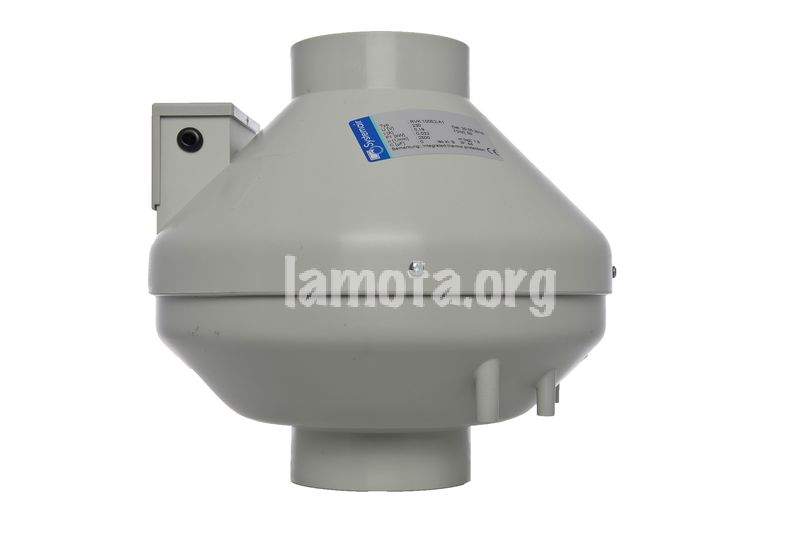
Here is a simple calculation used by many growers:
Exhaust fan: Potential volumetric capacity of the fan (m³/h) = Volume of the active growing space* (m³) x Air exchange time (hours) x Loss of efficacy.
*Length by width by height of the grow room containing the equipment and the plants
As an example, let's take a basic set up of 1.20 x 2.40 x 2.5 m (7,20 m3) with two 600 W HPS lamps.
Once you have calculated the volume of the growing area you just have to multiply it by the circulating air volume per hour. In indoor set-ups that are not air conditioned or CO2-enriched, where one inch equals 1/minute, this is calculated by multiplying the volume of the growing space by 60 (minutes).
Consider that if you are using a carbon active filter, this will cause a loss of efficiency of about 25 per cent of the potential capacity of the fan. Obviously, this will vary according to the diameter and the condition of the filter as well as to the length of the duct, but in any case 25 per cent is a fairly safe margin. The only thing you need to do is multiply the result by 1.25.
Potential volumetric capacity of the fan (m³/h) = (Volume of the active growing space (m³) x 60) x 1.25, which gives you the minimum volumetric capacity required.
Minimum volumetric capacity required = ((1.2 x 2.4 x 2.5) x 60) x 1.25= 540 m3/h.
The above result is the minimum exhaust capacity of the fan in m3/hour, in this case 540 m3/h. That said, remember that, where possible, it is best to opt for higher performing models.
Going back to the example, you could choose a Max-Fan Pro AC 60/615, which has a 615 m3 exhaust capacity and a 60 mm duct. Alternatively, the RVK 150 Sileo E2 L1 (720 m3/h and 150 mm duct) will give you a greater margin.
Now that you have a clearer idea of how to go about air management in indoor growing, we wish you the best of success with your crops.



Comments from our readers
Read comments in other languages:
Did you like this post?
Your opinion about our seeds is very important to us and can help other users a lot (your email address won't be made public).